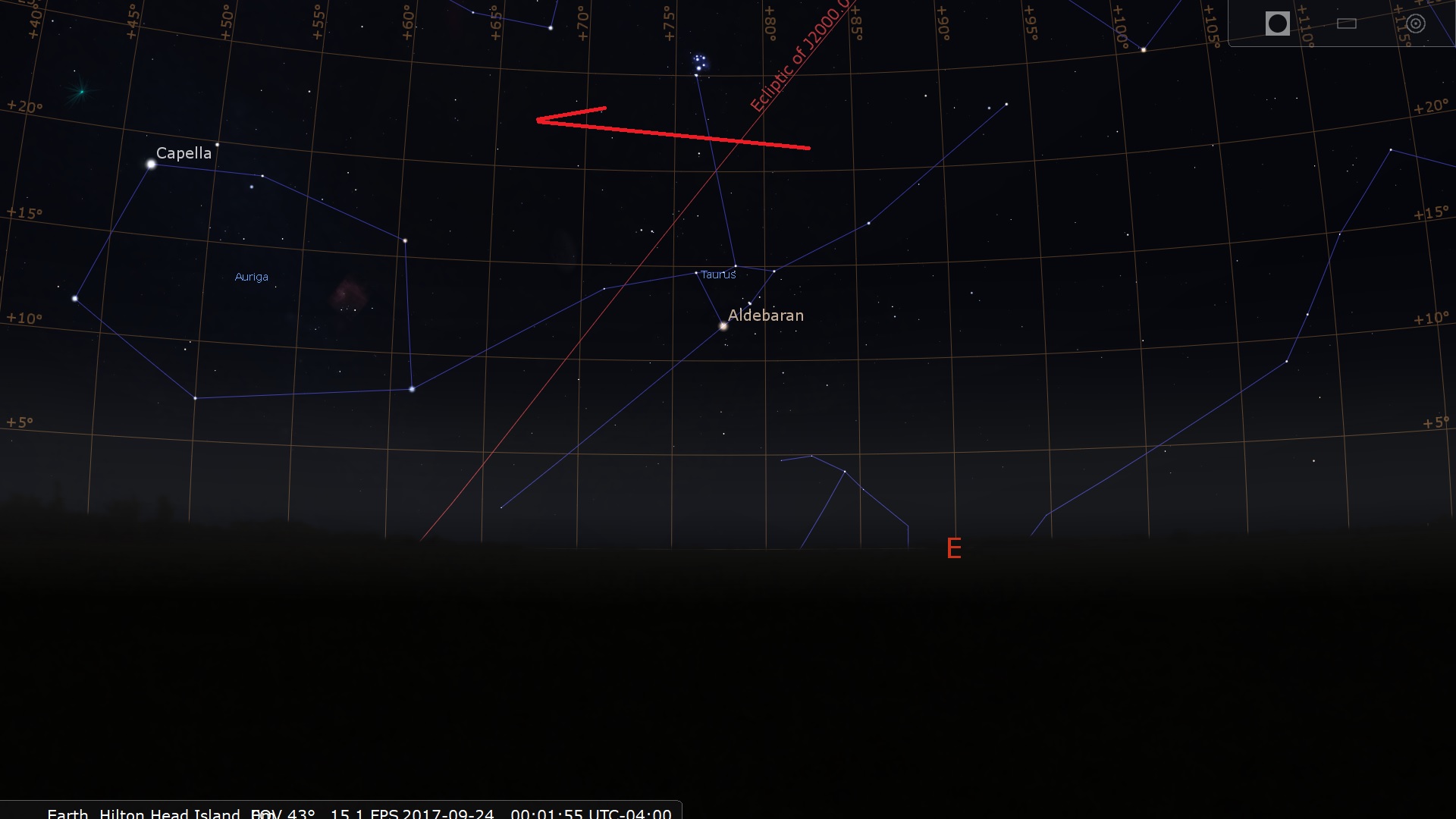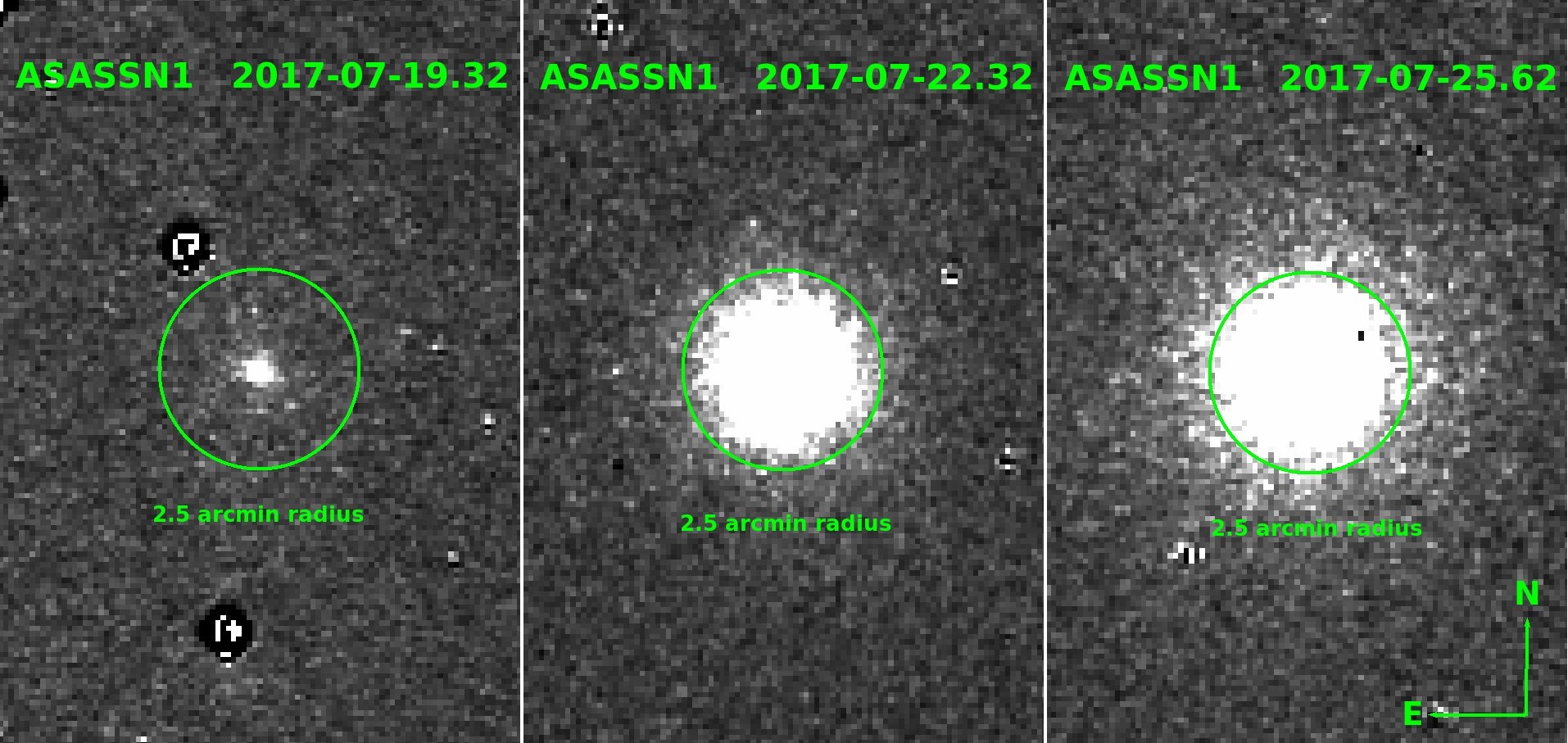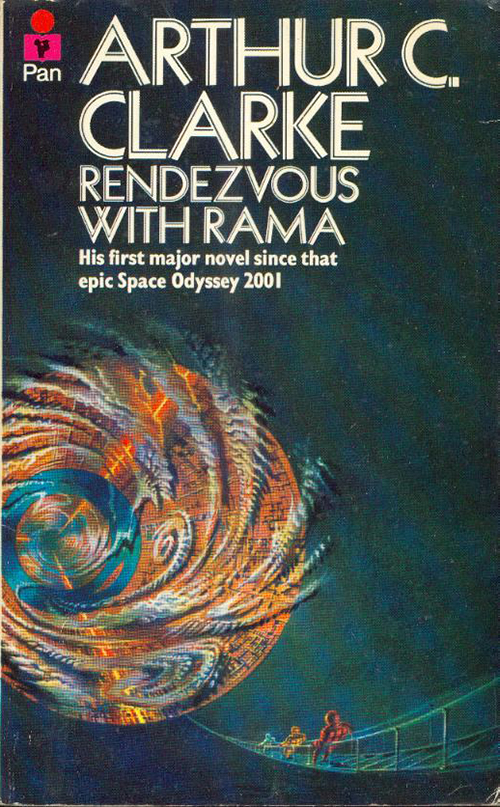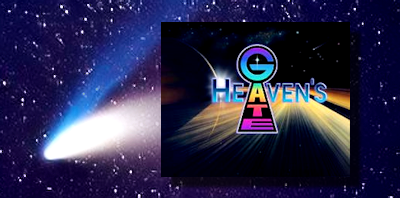
The path of Comet C/2017 O1 ASAS-SN parallel to the eastern horizon through September as seen from latitude 30 degrees north.
Credit: Stellarium
Posted on 07/27/2017 10:06:47 AM PDT by BenLurkin
When it was discovered on July 19th, 2017 by the All Sky Automated Survey for Supernovae (ASAS-SN) system, Comet O1 ASAS-SN was at a faint magnitude +15.3 in the constellation Cetus. In just a few short days, however, the comet jumped up a hundred-fold in brightness to magnitude +10, and should be in range of binoculars now. Hopes are up that the comet will top out around magnitude +8 or so in October, as it transitions from the southern to northern hemisphere.
Never heard of ASAS-SN? It’s an automated sky survey hunting for supernovae in both hemispheres, with instruments based at Haleakala in Hawaii and Cerro Tololo in Chile. Though the survey targets supernovae, it does on occasion pick up other interesting astronomical phenomena as well....
...
On a long term parabolic orbit probably measured in the millions of years, O1 ASAS-SN has an orbit inclined 40 degrees to the ecliptic, and reaches perihelion 1.5 AU from the Sun just outside the orbit of Mars on October 14th. This is most likely Comet C/2017 O1 ASAS-SN’s first passage through the inner solar system.
Currently located in the constellation Eridanus, hopefully comet O1 ASAS-SN’s current outburst holds. Expect it to climb northward through Taurus and Perseus over the next few months as it begins the long climb towards the north celestial pole.
As seen from latitude 30 degrees north, the comet will move almost parallel to the eastern horizon, and clears about 20 degrees altitude around local midnight, very well placed for northern hemisphere observers.
At its closest in mid-October, Comet O1 ASAS-SN will be moving a degree a day through the constellation Camelopardalis.
(Excerpt) Read more at universetoday.com ...


Let me know when it passes Uranus...................
Excellent!
If it starts slowing down we have a problem.....................
Exactly. If it’s a deceleration burn......


You would need a huge set of binocs to see a mag-10 object, even from dark skies. Better chance when/if it reaches mag-8.
________________________
The scale below is given as an instructive tool, to give a general idea of how the magnitude scale works. The scale below is intended to be roughly visual; the human eye's (dark-adapted) detection efficiency peaks around 495 nanometers, while the formal photoelectric V peak (a filtered band intended to be close to visual) is around 550 nm; CCDs tend to peak around 700 nm. The examples are given for integer values are not "exact", in that celestial objects are often measured to a precision or 0.1 or 0.01 magnitude; for example, Sirius shines at V = -1.47 (Yale Bright Star Catalogue), and the planet Venus varies in brightness generally from magnitude -4.5 to -3.7. Note that a comet of magnitude 5 will not be as easy to see as a star of magnitude 5, because that same amount of brightness that is concentrated in a point for the star is spread out over a region of the sky for a diffuse comet with a relatively-large coma.
Magnitude Needed to see an object of this brightness* Examples
-26 the sun
-13 full moon
-6 crescent moon
-4 naked eye: easy even from large cities planet Venus
-2 naked eye planet Jupiter
-1 naked eye brightest star,
Sirius; totally-
eclipsed moon;
C/1995 O1 (Hale-
Bopp) near peak
0 naked eye: difficult if near bright summer evening star
artificial lights but generally Vega; C/1996 B2
visible even from large cities (Hyakutake) at peak
+1 naked eye: brilliant as seen from planet Saturn
dark, rural areas
+2 naked eye: difficult but visible from stars of Big Dipper
small cities and suburbs; diffuse Halley's comet in
objects such as comets may require 1986 near peak
small binoculars from urban areas
3 naked eye: rural, suburban, small city faintest naked-eye
binoculars: bright, urban areas stars visible from
many smaller
cities/inner
suburbs;
4 naked eye: (outer) suburbs faintest naked-eye
binoculars: cities (stars), suburban stars visible from
areas (diffuse objects such as comets) many smaller
cities/(outer)
suburbs
5 generally binocular objects from urban moons of Jupiter
and suburban areas; faintest naked-eye
stars visible from "dark" rural areas
located some 40 miles (60 km) from
major cities
6 binocular objects from suburban areas; planet Uranus
faintest naked-eye stars visible from
"dark" rural areas located some 100
miles (150 km) from major cities
7 binoculars; faintest naked-eye stars brightest minor
visible from "dark" rural areas planet (asteroid)
located some 140 miles (200 km) from and about 1-2
major cities and some 30 miles (50 km) comets each year
from nearest town of population 5000
or so
8 binocular objects; from urban areas, such planet Neptune
objects may only be visible with small
telescopes
10 from dark sky, objects visible with at any given
20x80 binoculars; from brighter sites, time, there are
a larger telescope is needed usually a couple
of comets this
bright
11 general limiting visual brightness# of
comets with a 15-cm-aperture reflector
12 general limiting visual brightness# of at any given time,
comets with a 20-cm-aperture reflector there are usually a
half dozen comets
this bright
13 general limiting visual brightness# of
comets with a 25-cm-aperture reflector
14 general limiting visual brightness# of Pluto at its brightest
stars with a 20-cm-aperture reflector
15 general limiting visual brightness# of
comets with a 50-cm-aperture reflector
19 general limiting photographic brightness#
of comets with a 50-cm-aperture
reflector
21 general limiting brightness of stars with
a 60-cm-aperture reflector + CCD
22 general limiting brightness# of comets with
a CCD and 150-cm-aperture reflector
* naked-eye viewing assumes 20-20 vision (corrected or uncorrected)
# from a dark, rural site; "visual" as compared to "photographic" or
"CCD-detected"; "reflector" means "reflecting telescope"
Interesting.
Rather strange behavior for a newly discovered comet........Have they looked at it with HUBBEL?

Founding member Benjamin Shappee and team have 498 bright supernovae and numerous other transient sources to their credit, but this is the group’s first comet discovery, ASASSN1 (C/2017 O1).
The 15th-magnitude object was caught before dawn on July 19th in the constellation Cetus using data from the quadruple 14-cm “Cassius” telescope on Cerro Tololo, Chile.
Don’t be put off by that magnitude. The comet has brightened quickly in the past few days; visual observers are now reporting it at around magnitude +10 with a large, weakly condensed coma.
Chris Wyatt of Australia relates that a Swan band filter does a great job enhancing the apparent brightness and contrast of the coma, a sign this is a “gassy” comet.
I concur with Chris.
On the morning of July 27.3 UT from near Duluth, Minn., I found the comet large, faint and diffuse in my 10-inch at 57x from Duluth, Minn.
The Swan filter gave it a welcome boost. Some fire haze was present in the air at the time which may account for it being fainter than expected. With a coma across, this thing’s big!
Assuming the orbit remains close to the current calculation, Comet ASASSN1 will move northeast across Cetus and Taurus this summer and fall, slowly brightening as it approaches perihelion on October 14th in Perseus. It comes closest to the Earth four nights later, missing the planet by a cool 67 million miles.
In a fun twist, ASASSN1 will slow down and spend the entire month of December and much of January within a few degrees of the North Star!
Still, don’t count your comets before they hatch. Or even after. Hairy stars can be fickle. There’s a fair chance we’re only seeing a temporary bright outburst of an intrinsically faint comet. But who knows? You and I will have to keep track of it to find out.
Right now, ASASSN1 stands about 20deg high in the southeastern sky as it crosses from Cetus into Eridanus. An 8-inch telescope should have no problem bringing it to life, especially now that the Moon’s out of view and won’t return to the morning sky until August 6th.
You can stay in touch with the latest developments on Shappee’s Twitter page.
While you’re out waiting for the comet to climb out of the haze, why not check out the new supernova, SN 2017fgc, which recently exploded into view in the 11th-magnitude galaxy NGC 474 in Pisces.
At magnitude +13.7, you wouldn’t call it “bright,” but it’s been rising since the DLT40 Survey discovered it on July 11th.

The nova ASASSN-17hx jumps in brightness between June 23 and July 13 in this then-and-now animation.
Gianluca Masi / Virtual Telescope Project
Based on spectra taken of the object, it was still a couple weeks before maximum in mid-July, so I wouldn’t be surprised if it continues to brighten.
Lots of supernovae appear close to the nuclei of their host galaxies and are notoriously difficult to discern in the dense fuzz of unresolved starlight. Not this one. It’s 116deg in the clear east and 45deg north of the galaxy’s center, so you won’t break an eyeball trying to see it.
An 8-inch scope magnifying around 150-200x should coax it into view on a dark, moonless morning. It was very easy to spot at 157x in the 10-inch at magnitude +13.5 on July 27.4 UT. Take a minute with the side-by-side galaxies, a great sight in its own right.
When you bring this catastrophic pinpoint into focus, you’ll be looking at what happens when a white dwarf star gains too much weight. After siphoning material from a close companion star for millennia, the dwarf exceeded its maximum weight of 1.4 solar masses and underwent a catastrophic gravitational collapse.
The runaway fusion reaction that followed raced through the star, destroying it in one titanic blast. Overnight, a lowly white dwarf became a Type Ia supernova, bright enough to see from 96 million light years, the distance to the host galaxy.
Finally, a nova that’s been dozing away at 12th-magnitude has started kicking out the jams! Since it’s discovery on June 23rd, ASASSN-17hx has brightened nearly two full magnitudes, putting it within range of large binoculars and small telescopes.
As you can tell from the object’s name, the ASAS-SN crew has been busy! Currently at about magnitude +9.0 (and still rising) in the Scutum Milky Way, it’s well-placed for viewing at nightfall a few degrees below the tail of Aquila, the Eagle.
Like a Type Ia supernova, a nova occurs in a close binary star system where a normal star like our Sun is paired up with a white dwarf. Material pulled from the companion finds its way by way of accretion disk to the surface of the dwarf, where it accumulates, heats up, and ignites in a thermonuclear explosion. A sudden increase in brightness follows on the heels of the blast that raises the star from obscurity to binocular or even naked-eye visibility.
Unlike a supernova, the dwarf in this system remains intact and the process begins anew. It’s estimated that small white dwarfs have repeat nova outbursts about once every 5 million years; for larger dwarfs, it’s about every 30,000 years. The most massive must take care as they teeter close to the 1.4-solar mass limit. If a dwarf doesn’t burn and destroy the accumulated fuel in time, the extra mass can push it past the limit to supernova-dom.
Comet ASASSN1 looks too much like:
Comet ASSASSIN 1...................
When it gets to ASASSN-8, then I’ll get worried…
Love it! Should’ve read the whole article, but first pass through the inner solar system (none of the volatiles have burned off on previous passes), increased in magnitude a hundred fold in a few days... Wow, might be a spectacular comet! Hope so for all of us; not many people get to see one.

“Heaven’s Gate was an American UFO religious millenarian group based in San Diego, California, founded in 1974 and led by Marshall Applewhite (1931–1997) and Bonnie Nettles (1927–1985).[1]
On March 26, 1997, police discovered the bodies of thirty-nine members of the group who had participated in a mass suicide in order to reach what they believed was an extraterrestrial spacecraft following Comet Hale–Bopp.[2][3]”
https://en.wikipedia.org/wiki/Heaven%27s_Gate_(religious_group)
_______________________________


If I remember correctly, most of the men had de nutted themselves in preparation for their journey.
If only they had "de-nutted" themselves in the mental sense, as opposed to the physical. They may have been able to recover from that crazy episode and moved on with their lives.
Disclaimer: Opinions posted on Free Republic are those of the individual posters and do not necessarily represent the opinion of Free Republic or its management. All materials posted herein are protected by copyright law and the exemption for fair use of copyrighted works.